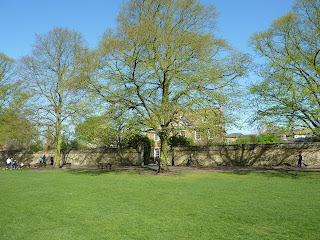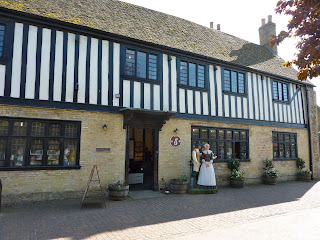Last Saturday was such a lovely spring day, I wanted to be out, but not necessarily out walking the whole day, so we drove off to spend the day in Ely, about 70 miles from London in the fenlands of North Cambridgeshire. We are cathedral junkies, and Ely was one of the first cathedrals we visited when we were new in England. We had been back once or twice, but not for many years.
The Fens are the marshy lands of East Anglia and Lincolnshire, that were first drained by the Romans, and then seriously drained in the 17th century by wealthy land owners using Dutch technology to create rich agricultural land from the drained peat bogs. Before the drainage, the high land areas were often referred to as Isles. In the early years of Saxon Christianity, St Etheldreda, a local princess, founded a monastery at Ely in 673. Her monastery was destroyed by the Vikings in 870, but rebuilt a hundred years later as a Benedictine house. In 1066, the Normans came and conquered, but they did not conquer the Saxon stronghold of East Anglia for another four years. When the Normans conquered, they built castles and cathedrals as quickly as they could to secure their foothold. Ely Cathedral was begun in the 1080s.
 |
| The West Tower |
This is the north side of the cathedral showing the exterior of the special spaces within the cathedral in the photos I took on Saturday. From the right is the edge of the West Tower where you enter the cathedral. The nave behind it is 248 feet long. The nave ends at the Octagon, built in the 14th century after the Norman central tower collapsed in 1322. To the left is the North Transept which was begun in 1080. Finally, the large Gothic window to the far left is the Lady Chapel, the largest Lady Chapel in England, added in 1349.
Here is Bob in the South aisle of the nave. The rounded Norman arches with the alternating columns of solid drums and carved piers.
The exterior walls of the nave are filled with Victorian glass that shimmered beautifully in Saturday's sunlight.
The interior of the Octagon roof with the light pouring down into the crossing.
The arches around the Octagon are carved with heads and with scenes from Etheldreda's life.
The North Transept is quite plain, but the symmetry of the rounded arches is elegant.
Except for the painted 15th century Hammerbeam ceiling with the flying angels that appear in two rows along the side edges of the ceiling.
The Lady Chapel is a stunningly beautiful space. By the 14th century, the Cult of Mary was well established, and every church was adding a space devoted to the Lady who could intervene with her Son to grant the prayers of the faithful. From the first photo above, you can see the Lady Chapel was separate from the main building, connected by a narrow vaulted aisle. The fan vaulted ceiling is dotted with beautifully carved and painted bosses. The transition into Gothic Chapel with narrow piers and huge windows creating a light filled space in contrast to the dark mysterious space of the Norman Romanesque cathedral interior must have been a religious experience itself.
The Chapel walls are ornately carved along the arcades along all sides. Look closely though and you will see that every face or head has been carefully chipped away. There must have been a thousand heads in this chapel, gone forever, thanks to the iconoclasm frenzy of Thomas Cromwell's Dissolution troops. Thomas has never been one of my favourites because of this destruction. When my reading eyesight went sour, I had only finished the first section of Wolf Hall, and was feeling quite sad for him. When I get back to reading, I will remember these missing heads however.
England's cathedrals do pride themselves on being living monuments, and most of them have examples of contemporary religious art.
The Lady Chapel at Ely has had this modern Mary for several years, but the new metalwork reredos was just installed earlier this year. I am warming to Mary, but this posted sign indicates not everyone feels the same way.
Looking through my photos, and the new book we bought about the cathedral on Saturday has made me realise we are way out of practice with our church tourism forays. We missed so many treasures on this trip. Perhaps it was because it was the lure of the beautiful day outside or perhaps it was the lure of our next stop at Topping & Company, one of the best bookstores in England. (We had been to the Bath branch several years ago, but never to Ely's branch.)
After time well spent supporting a local independent bookseller and a superb lunch of codfish cakes for me and sausages for Bob in the garden of the Prince Albert . . .
. . . We headed to the Oliver Cromwell House . . .
where he lived with his family in the years before he went off to protect England from the King and the Papists, instead of bunking off with the rest of his Cambridge cohort to Massachusetts to found towns like Boston and Hingham and Braintree and Needham and Ipswich and so many others. (It can be very confusing to drive around East Anglia if you have previously lived in Eastern Massachusetts.) I guess that's why there is no Ely, Massachusetts. The Cromwell House devotes a little bit of their display to the question of Hero or Villain? But their answer is clearly Hero.
The House included a very interesting short film on the draining of the Fenlands. As an MP, Cromwell was an advocate for his constituents forced off the land by the enclosures and the drainages. So we headed over to the local history museum for more displays about traditional agriculture in the Fens. Another weekend, we will go back to visit the agricultural museums that explain the technology of the drainage systems that still keep the land from returning to marshy waterland.
A lovely day out. Next weekend, we head back to East Anglia to look at a possible wedding venue in Suffolk.















No comments:
Post a Comment